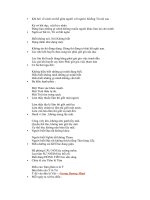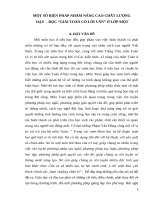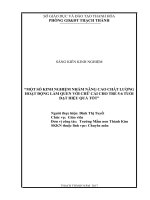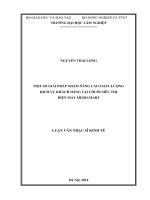Một Số Lỗi Đường May không đạt chất lượng trên sản phẩm Denim - Common denim seam unqualities common denim seam quality defects
Bạn đang xem bản rút gọn của tài liệu. Xem và tải ngay bản đầy đủ của tài liệu tại đây (720.27 KB, 6 trang )
COMMON SEAM QUALITY DEFECTS
AMERICAN EFIRD, INC.
Page 1 of 6
www.amefird.co
m
American & Efird, Inc. 2005. All International Rights Reserved.
COMMON SEAM QUALITY DEFECTS
AMERICAN EFIRD, INC.
SEAM UNQUALITY PHOTO OR DRAWING DESCRIPTION RECOMMENDED SOLUTIONS
BROKEN STITCHES - NEEDLE CUTTING
BROKEN STITCHES - NEEDLE CUTTING - where the thread is being
broken where one seam crosses another seam (ex: bartacks on
top of waistband stitching, seatseam on top of riser seam)
resulting in stitch failure.
MINIMIZING BROKEN STITCHES DUE TO NEEDLE CUTTING
- 1) Use a higher performance Perma Core or D-Core
thread. 2) Use a larger diameter thread on operations
where the thread is being cut. 3) Make sure the proper
stitch balance is being used. On a chainstitch seam on
denim, you normally would like to maintain a 60%/40%
relationship of Needle thread to Looper thread in the
Seam. 4) Use needles with the correct needle point. 5)
Change the needles at regular intervals on operations
where the Needle Cuts are occurring frequently.
BROKEN STITCHES - ABRASION
BROKEN STITCHES - ABRASION - where thread on the stitch line
is broken during stone-washing, sand blasting, hand sanding, etc.
Broken stitches must be repaired by restitching over the top of
the stitch-line.
MINIMIZING BROKEN STITCHES DUE TO ABRASION - 1)
Use a higher performance
Perma Core
or
D-Core
thread;
2) Use a larger diameter thread on operations where
excessive abrasion is occuring (ex: use T-120 on
Waistband); 3) Make sure stitches are balance properly, 4)
Use a
Magic
air entangled thread in the Looper due to its
lower seam profile making it less susceptible to abrasion
(ex: use T-90 or T-135 Magic in loopers of the Yoke, Seat
and Waistband seam); 5) Monitor the Finishing Cycle for
compliance to specs.
BROKEN STITCHES - CHEMICAL DEGRADATION
BROKEN STITCHES - CHEMICAL DEGRADATON - where thread is
being compromised by the chemicals used during laundering
resulting in loss or change of color and seam failure.
MINIMIZING BROKEN STITCHES DUE TO CHEMICAL
DEGRADATION - 1) Use a higher performance Perma Core
NWT that has greater resistance to chemical degradation.
2) It is recommended to go to larger thread sizes when the
Denim Garments will be subject to Harsh Chemical
washes. 3) To achieve the best laundering results make
sure that the water temperatures and PH Levels are
correct and that the proper amounts and sequence of
chemical dispersion are within guidelines. 4) Make sure
the garments are being rinsed properly to neutralize the
chemicals in the fabric. 5) Monitor the drying process,
cycle times, and temperatures to make sure they are
correct so that the best possible garment quality can be
achieved.
A&E's new Perma Core NWT was designed to today's more
demanding finishing processes. Note the Picture to the left. The
seam on the right was sewn with this new thread.
Here is an example of where the Cotton wrapper has
been degraded by the harsh chemicals during
Laundering
Too much chemical
Too long wash or drying cycles
Improper Rinsing
Too high of Temperature
Note: Corespun threads with their continuous filament core has
much greater resistance to chemical degradation than spun
polyester threads.
Row of Stitch
on right sewn
with
Perma Core
NWT
Here the looper thread has been broken due to harsh
abrasion during stone-washing.
Thread Tension Too Tight
Proper Thread Tension
Note: Using the proper thread and maintaining the proper stitch
balance are the two best ways to minimize broken stitches due
to Needle Cutting.
Page 2 of 6
www.amefird.co
m
American & Efird, Inc. 2005. All International Rights Reserved.
COMMON SEAM QUALITY DEFECTS
AMERICAN EFIRD, INC.
SEAM UNQUALITY PHOTO OR DRAWING DESCRIPTION RECOMMENDED SOLUTIONS
UNRAVELING SEAMS
UNRAVELING SEAMS - generally occurs on 401 chainstitch seams
where either the stitch has been broken or a skipped stitch has
occurred. This will cause seam failure unless the seam is
Restitched.
MINIMIZING UNRAVELED STITCHES - 1) Use a high
performance Perma Core or D-Core thread that will
minimize broken stitches and skipped stitches; 2) Insure
proper machine maintenance and sewing machine
adjustments; 3) Observe sewing operators for correct
material handling techniques.
RESTITCHED SEAMS
RESTITCHED SEAMS - where there is a "splice" on the stitch line.
If this occurs on Topstitching, then the seam does not appear to
be 1st quality merchandise. Caused by 1) thread breaks or thread
run-out during sewing; or 2) cut or broken stitches during a
subsequent treatment of the finished product (I.e., stone
washing).
MINIMIZING RESTITCHED SEAMS - 1) Use a better quality
sewing thread. This may include going to a higher
performance thread designed to minimize sewing
interruptions. (see A&E "Thread Selection Guide" and/or
A&E's Technical Bulletin "Minimizing Thread Breakage &
Skipped Stitches"); 2) Insure proper machine maintenance
and sewing machine adjustments; 3) Make sure sewing
machines are properly maintained and adjusted for the
fabric and sewing operation; (see A&E's Technical Bulletin -
"Machine Maintenance Checklist". 4) Observe sewing
operators for correct material handling techniques.
SAGGING OR ROLLING POCKET
SAGGING OR ROLLING POCKETS - where the pocket does not lay
flat and rolls over after laundering.
MINIMIZING SAGGING OR ROLLING FRONT & BACK
POCKETS - 1) Make sure the sewing operators are not
holding back excessively when setting the front pocket. 2)
Make sure the hem is formed properly and that excessive
fabric is not being being put into the folder that will cause
the hem to roll over. 3) Check to make sure pocket is cut
properly and that pocket curve is not too deep. 4) Use a re-
enforcement tape on the inside of the pocket that may
help prevent the front panel from stretching along the bias
where the front pocket is set. 5) The type and weight of
denim, along with the fabric construction, may contribute
to this problem. Contact your fabric supplier for assistance.
Excessive Restitched Seams
See A&E Technical Bulletins on our web-site on
"Minimizing Thread Breakage and Skipped
Stitches" and "Machine Maintenance Checklist".
Skipped Stitch
Broken Stitch that is unraveling
Setting the front
pocket with a
re-enforcement tape.
Note: In some cases the rolling may be an inherent characteristic
of the fabric.
Page 3 of 6
www.amefird.co
m
American & Efird, Inc. 2005. All International Rights Reserved.
COMMON SEAM QUALITY DEFECTS
AMERICAN EFIRD, INC.
SEAM UNQUALITY PHOTO OR DRAWING DESCRIPTION RECOMMENDED SOLUTIONS
EXCESSIVE SKIPPED STITCHES
SKIPPED STITCHES - where the stitch forming device misses the
needle loop or the needle misses the looper loop. Skips are usually
found where one seam crosses another seam and most of the time
occurs right before or right after the heavy thickness.
MINIMIZING SKIPPED STITCHES - 1) Use corespun thread.
2) Use minimum thread tension to get a balanced stitch. 3)
Use the ideal foot, feed and plate that helps to minimize
flagging. 4)Training sewing operators NOT to stop on the
thickness. 5) Make sure the machine is feeding properly
without stalling. 6)Make sure the machine is not back-
feeding.
RAGGED / INCONSISTENT EDGE ON OVEREDGE
OR SAFETYSTITCH SEAMS
RAGGED / INCONSISTENT EDGE - where the edge of the seam is
either extremely "ragged" or "rolls" inside the stitch.
SOLUTIONS TO RAGGED / INCONSISTENT EDGE - 1) Make
sure the sewing machine knives are sharpened and
changed often; 2) The knives should be adjusted properly
in relationship to the "stitch tongue" on the needle plate to
obtain the proper seam width or width bite.
WAVY SEAMS ON STRETCH DENIM
WAVY SEAMS ON STRETCH DENIM - where the seam does not lay
flay and is wavy due to the fabric stretching as it was sewn or
during subsequent laundering and handling operations.
SOLUTIONS FOR WAVY SEAMS ON STRETCH GARMENTS
1) Use minimum presser foot pressure; 2) Instruct sewing
operators to use proper handling techniques and not
stretch the fabric as they are making the seam. 3) Where
available, use differential feed to compensate for the
stretch of the fabric.
ExcessiveSkipped Stitches
Page 4 of 6
www.amefird.co
m
American & Efird, Inc. 2005. All International Rights Reserved.American & Efird, Inc. 2005. All International Rights Reserved.American & Efird, Inc. 2005. All International Rights Reserved.
COMMON SEAM QUALITY DEFECTS
AMERICAN EFIRD, INC.
SEAM UNQUALITY PHOTO OR DRAWING DESCRIPTION RECOMMENDED SOLUTIONS
ROPY HEMS
ROPY HEM - is where hem is not laying flat and is skewed in
appearance.
SOLUTIONS FOR ROPY HEMS - 1) Usually caused by poor
operator handling. Instruct the sewing operator to make
sure they get the hem started correctly in the folder before
they start sewing. Also, make sure the don't hold back
excessively as the seam is being sewn. 2) Use minimum
roller or presser foot pressure.
TWISTED LEGS
TWISTED LEGS - is where the sideseam twists around to the front
of the pant and distorts the appearance of the jeans.
SOLUTIONS FOR TWISTED LEGS - 1) Usually caused by
poor operator handling. Instruct the sewing operator to
match the front and back properly so they come out the
same length. Sometimes notches are used to insure proper
alignment. They should NOT trim off the front or back with
scissors to make them come out the same length. 2) Make
sure the cut parts are of equal length coming to the
assembly operation. 3) Check fabric quality and cutting for
proper skew. 4) Make sure the sewing machine is adjusted
properly for uniform feeding of the top and bottom plies.
DISAPPEARING STITCHES ON STRETCH KNITS
DISAPPEARING STITCHES IN STRETCH DENIM - is where the
thread looks much smaller on seams sewn in the warp direction
than in the weft direction of the fabric.
SOLUTIONS TO MINIMIZING DISAPPEARING STITCHES
ON STRETCH DENIM - 1) Use a heavier thread size (T-120,
T-135, T-150) on topstitching. 2) Go to a longer stitch
length (from 8 to 6 spi). 3) Make sure the thread tensions
are as loose as possible so the thread sits on top of the
fabric rather than burying in the fabric on seams sewn in
the warp.
Notice that the thread looks much smaller on the seat
seam as compared to the Yoke seam.
Page 5 of 6
www.amefird.co
m
American & Efird, Inc. 2005. All International Rights Reserved.
COMMON SEAM QUALITY DEFECTS
AMERICAN EFIRD, INC.
SEAM UNQUALITY PHOTO OR DRAWING DESCRIPTION RECOMMENDED SOLUTIONS
THREAD DISCOLORATION AFTER LAUNDRY
THREAD DISCOLORATION AFTER LAUNDRY - is where the thread
pics up the indigo dyes from the fabric giving the thread a 'dirty'
appearance. A common discoloration would be the pick-up of a
greenish or turquoise tint.
SOLUTIONS TO THREAD DISCOLORATION - 1) Use thread
with proper color fastness characteristics. 2) Correct PH
level (too low) and Water Temperature (too low) during
laundry. 3) Use the proper chemicals & laundry cycles. 4)
Use Denimcol PCC in wash or similar additive, 5) Do Not
overload washers with too many garments at one time.
POOR COLOR FASTNESS AFTER LAUNDRY
POOR COLORFASTNESS AFTER LAUNDRY - is where the thread
does not washdown consistently in the garment or changes to a
different color altogether.
SOLUTIONS TO POOR COLORFASTNESS AFTER LAUNDRY -
1) Use thread with proper color fastness characteristics. 2)
Use threads from the same thread supplier and do not mix
threads in a garment. 3) Always do preproduction testing
on denim garments using new colors to assure that they
will meet your requirements. 4) Make sure sewing
operators select thread by type and color number and do
not just pick a thread off the shelf because it looks close in
color.
Notice how the bartack thread washed down differently
than the Topstitching thread.
Improper PH level
Improper Water Temperature
Improper Chemical Selection
Shortcuts on Wash Method
Mixing threads in a Garment
Using threads with different color fastness
Not doing pre-production testing
Note: If preproduction testing shows a problem, then make sure
to contact your global thread company for assistance.
Page 6 of 6
www.amefird.co
m
American & Efird, Inc. 2005. All International Rights Reserved.









